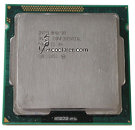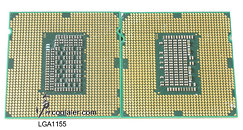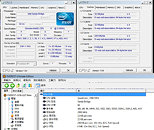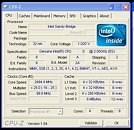Thursday, June 10th 2010

Intel Sandy Bridge Quad-Core Processor Tested
At this year's Computex event, some of the most unexpected exhibits were socket LGA1155 motherboards based on Intel 6-series chipsets, across the board, from virtually every major motherboard vendor. Unexpected, because it's been less than an year since released mainstream derivatives of the Nehalem/Westmere architectures that use the LGA1156 socket. LGA1155 will form the base for performance, mainstream, and value segments of processors based on the upcoming Sandy Bridge architecture, which is a generation successor of Nehalem. With so many motherboard vendors showing off their creations in release-grade conditions, it is obvious that engineering samples of processors to go with them are already on the loose and will land in some enthusiast's hands. It did, in the skillful hands of Coolaler, who wasted no time in putting it through a quick run through popular benchmarks.
Coolaler tested an LGA1155 quad-core processor operating at 2.5 GHz, which CPU-Z can't name but marks it as a Sandy Bridge engineering sample. Among the little that's known about this processor, is that it has a base clock speed of 100 MHz (Nehalem/Westmere processors use BClk of 133 MHz), which means that to achieve 2.5 GHz, it uses a multiplier value of 25. It has all the instruction sets of Westmere including SSE 4.2 and AES acceleration, but also features AVX (Advanced Vector Extensions), a successor to SSE 4.2 which expands the processor's number crunching abilities, and increases performance per MHz. The cache structure up to the second level is the same (32 KB L1I, 32 KB L1D, 256 KB /core L2), but uses a smaller L3 cache at 6 MB (compared to 8 MB on Lynnfield). HyperThreading technology provides the OS with 8 logical CPUs to deal with.The setup was aided with 4 GB of DDR3 memory and ATI Radeon HD 5800 series graphics. The processor crunched Super Pi 1M in 16.349 s, it scored 371 points in CPU Mark. In the multi-threaded Cinebench R11.5 benchmark, the 2.5 GHz chip scored a little under Core i7 860 (reference score). In the Everest CPU Queen, it's about as fast a Core i5 750 from what we could say, but in the Photoworxx test, it outperformed the Core i7 965 XE. In a separate set of tests run on the same hardware albeit in Windows XP, the processor was eight times faster than any other processor in the AES test (because of its native AES extensions), and edged the Core i7 965 XE in memory bandwidth despite having a narrower dual-channel DDR3 IMC.While the results don't show a revolutionary processor, it is intended to be one. Right now it's eligible for the benefit of doubt. The real benefits will be for those models which come with embedded graphics, since the IGP and memory controller will be present on the same die, instead of the present design where the package is an MCM for two dies: CPU and northbridge. When Sandy Bridge releases is a subject of immense speculation. Since motherboard makers unveiled such mature designs of LGA1155 motherboards as early as in June 2010, a market release of the platform may not be too far away.
Source:
Coolaler Forums
Coolaler tested an LGA1155 quad-core processor operating at 2.5 GHz, which CPU-Z can't name but marks it as a Sandy Bridge engineering sample. Among the little that's known about this processor, is that it has a base clock speed of 100 MHz (Nehalem/Westmere processors use BClk of 133 MHz), which means that to achieve 2.5 GHz, it uses a multiplier value of 25. It has all the instruction sets of Westmere including SSE 4.2 and AES acceleration, but also features AVX (Advanced Vector Extensions), a successor to SSE 4.2 which expands the processor's number crunching abilities, and increases performance per MHz. The cache structure up to the second level is the same (32 KB L1I, 32 KB L1D, 256 KB /core L2), but uses a smaller L3 cache at 6 MB (compared to 8 MB on Lynnfield). HyperThreading technology provides the OS with 8 logical CPUs to deal with.The setup was aided with 4 GB of DDR3 memory and ATI Radeon HD 5800 series graphics. The processor crunched Super Pi 1M in 16.349 s, it scored 371 points in CPU Mark. In the multi-threaded Cinebench R11.5 benchmark, the 2.5 GHz chip scored a little under Core i7 860 (reference score). In the Everest CPU Queen, it's about as fast a Core i5 750 from what we could say, but in the Photoworxx test, it outperformed the Core i7 965 XE. In a separate set of tests run on the same hardware albeit in Windows XP, the processor was eight times faster than any other processor in the AES test (because of its native AES extensions), and edged the Core i7 965 XE in memory bandwidth despite having a narrower dual-channel DDR3 IMC.While the results don't show a revolutionary processor, it is intended to be one. Right now it's eligible for the benefit of doubt. The real benefits will be for those models which come with embedded graphics, since the IGP and memory controller will be present on the same die, instead of the present design where the package is an MCM for two dies: CPU and northbridge. When Sandy Bridge releases is a subject of immense speculation. Since motherboard makers unveiled such mature designs of LGA1155 motherboards as early as in June 2010, a market release of the platform may not be too far away.








72 Comments on Intel Sandy Bridge Quad-Core Processor Tested
most people dont upgrade the cpu alone. they will also buy a new motherboard and maybe even ram.
technology moves forwards, there was clearly a hardware limitation with 1156 vs 1155, so out with the old in with the new.
this cpu/platform doenst really make sence. anyone who wants an office pc for basic stuff isnt going to be happy paying £400-500 just for there cpu/mobo.
I don't think integrated GPUs will take off in the enthusiast section anytime soon. But for e.g. laptops and HTPCs they would be pretty awesome. I don't see any reasons why Intel would try to retire the LGA-1156, which is only a year or two old. And I don't see any point in the LGA-2011 either. It will have quad-channel memory, 8 more PCIe lanes and support 8-core CPUs. But the problem is, for 90% of the users, the current sockets offer more than they need. There are few applications that fully utilise multi-core processing and Hyperthreading, and 4 or 6 GBs of RAM is enough for the most. And not that many games can use more than 2 cores.
Honestly, when these sockets come out, and you're concidering to update your LGA-1156 or LGA-1366, don't. Save your money, or spend it on some nice SSDs, RAM or a graphics card. That will definately give a more noticalbe increase in performance than upgrading your CPU or motherboard.
Also Core 2 Extremes are still epic chips. i7 runs faster but in games, most games will make do just fine on a Core 2 Extreme, or even a Quad or a Duo. Most games barely use 4 cores properly.
Gimme Sandy Bridge on Christmas:)
I personally don't give a $hit about the new sockets(maybe in a couple years i will), considering as a gamer, the 1366 socket is more then enough.(Hell, even a Core 2 Duo is enough)
on wikipedia, there appears to be a 65W quad core coming out, and that will probably be the only cpu i may get...
oh, and more reason to refuse to get sandy bridge: www.xbitlabs.com/news/mainboards/display/20100610103937_Intel_to_Cease_Supporting_PCI_Bus_with_Select_6_Series_Chipsets.html
no more PCI slots
The 2000 (?) 1366 socket replacement would have to show some serious improvements to entice me to buy yet another new mobo+processor+ram.
As for 1155 adding a IGP - that's fine and dandy for mums and dads/companies - but for enthusiasts, it's hardly a drawcard.
Native SATA/USB/PCI-E 3.0 is welcome - but it will be a while before there are enough mainstream devices available to warrant it the change so soon.